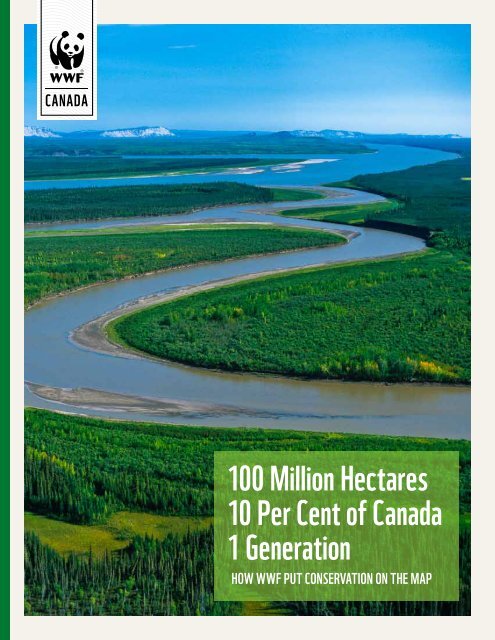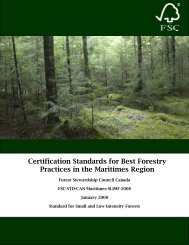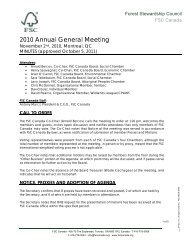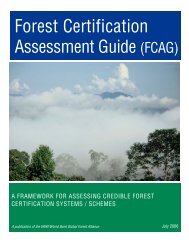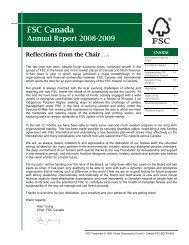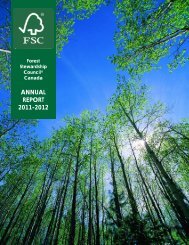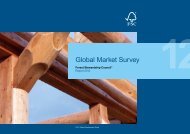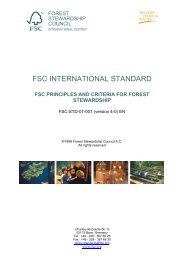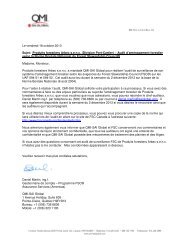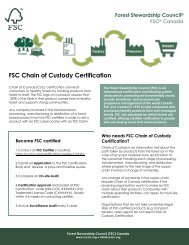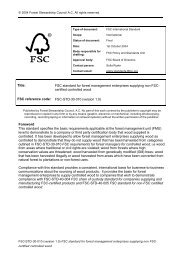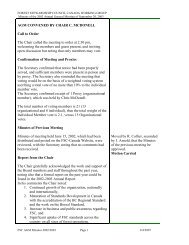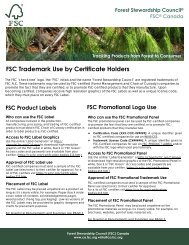100 Million Hectares 10 Per Cent of Canada 1 Generation - Forest ...
100 Million Hectares 10 Per Cent of Canada 1 Generation - Forest ...
100 Million Hectares 10 Per Cent of Canada 1 Generation - Forest ...
- No tags were found...
Create successful ePaper yourself
Turn your PDF publications into a flip-book with our unique Google optimized e-Paper software.
Front cover: Confluence <strong>of</strong> the Carcajou River and the MackenzieRiver, in the Mackenzie Valley in the Northwest Territories,<strong>Canada</strong> with the Carcajou Wetlands in the foreground.© Garth Lenz / WWF-<strong>Canada</strong>Published in November 20<strong>10</strong>© 1986 Panda symbol WWF-World Wide Fund For Nature(formerly known as World Wildlife Fund).® “WWF” and “living planet” are WWF Registered Trademarks.WWF is the planet’s leading conservation organizationregistered in <strong>Canada</strong> as a charity (no. 11930 4954 RR 0001).Any reproduction in full or in part <strong>of</strong> this publication mustmention the title and credit the above-mentioned publisheras the copyright owner. © text (20<strong>10</strong>) WWF-<strong>Canada</strong>.WWF is one <strong>of</strong> the world’s most experienced independentconservation organizations, with over 5 million supporters anda global Network active in more than <strong><strong>10</strong>0</strong> countries. WWF’smission is to stop the degradation <strong>of</strong> the planet’s naturalenvironment and to build a future in which humans live inharmony with nature, by: conserving the world’s biologicaldiversity, ensuring that the use <strong>of</strong> renewable natural resourcesis sustainable, and promoting the reduction <strong>of</strong> pollution andwasteful consumption.
AcknowledgementsThis isn’t a story about WWF. It’s about the people behind WWFwho made this work possible – far too many for us to thankindividually. However, we would like to <strong>of</strong>fer our gratitude inparticular to Susan Gibson, Bill Carpenter, Kim Bilous, Jim Lopez,Lewis Fix, and John Snobelen for contributing their memories andwisdom, as well as their enormous efforts to the successes describedin these pages. We would also like to thank every Canadian (all1 million <strong>of</strong> you) who signed the Wilderness Charter, as well as ourdonors, partners and collaborators from coast to coast to coast –these accomplishments belong to you as much as they do to us.for glenThis publication is dedicated in particular to Glen Davis, who inour view, helped protect more <strong>of</strong> <strong>Canada</strong> than any person beforehim. Glen was happiest when trekking across the tundra with thoseodd walking sticks, or when sifting along on the current <strong>of</strong> a remoteriver, or when treating his conservation friends at an outdoorstore. He was kind, funny, and deeply devoted to the wild. Most <strong>of</strong>all, Glen Davis was intelligently generous – a wise philanthropistwhose support made much <strong>of</strong> what is written about here possible.Though his legacy stands, his friends and his country still miss him.WWF-<strong>Canada</strong> <strong><strong>10</strong>0</strong> <strong>Million</strong> <strong>Hectares</strong> | page 1
© Greg STOTT / WWF-<strong>Canada</strong>
forewordGerald Butts,President and CEOFor millions <strong>of</strong> parents across thecountry, bedtime stories are a part<strong>of</strong> their nightly ritual with theirkids. <strong>Per</strong>sonally, I’ve spent manyevenings with my two children, bookin hand. I’ve also spent many hourscontemplating the state <strong>of</strong> the planetthat they’ll grow up to inherit.© WWF-<strong>Canada</strong>That’s why I’d like to share a different kind <strong>of</strong> story with you – the story <strong>of</strong>WWF-<strong>Canada</strong>. More than a chronology <strong>of</strong> milestones, <strong><strong>10</strong>0</strong> <strong>Million</strong> <strong>Hectares</strong>is about the way our organization works, how we catalyze the mindset, thepartnerships, the science and the actions that underpin transformativeconservation achievements.Today, Canadians are facing significant conservation challenges: the future <strong>of</strong>the Arctic, the health <strong>of</strong> our three oceans, the sustainability <strong>of</strong> our freshwatersupply and a dependence on fossil fuels that is driving global climate change.Our generation will be remembered for how we respond to these issues.Fundamentally, that is what drove me to join WWF. This is an organizationwith both the capacity and the approach to tackle these issues on a scalecommensurate with their global importance. I believe I can have no greaterimpact on the planet my children will inherit than through my work here.Of all the good reasons to support WWF, for me, that is the best.<strong><strong>10</strong>0</strong> <strong>Million</strong> <strong>Hectares</strong> is a powerful story, but it doesn’t end with this document.There is a new, ambitious chapter waiting to be written. I hope, as you readthe pages that follow, you feel as compelled and inspired as I did by what hasbeen, and can be, accomplished. If so, I invite you to join all <strong>of</strong> us at WWF as wecontinue doing the work that must be done for the future <strong>of</strong> our living planet.WWF-<strong>Canada</strong> <strong><strong>10</strong>0</strong> <strong>Million</strong> <strong>Hectares</strong> | page 3
How WWF Putconservationon the mapHow does one generation <strong>of</strong> workhelp conserve <strong>10</strong> per cent <strong>of</strong> <strong>Canada</strong>– over <strong><strong>10</strong>0</strong> million hectares <strong>of</strong> land?What does it take to create 1,000 newprotected areas, establish <strong>Canada</strong> asa global leader in sustainable forestryand make conservation a prerequisiteto industrial development in theNorthwest Territories? This is the story <strong>of</strong> how WWFcatalyzed changes that transformed the map <strong>of</strong> <strong>Canada</strong>– and rewrote the rules <strong>of</strong> conservation in the process.The year was 1989. In Ontario, hundreds <strong>of</strong> protesters were blockading a loggingroad in Temagami. In British Columbia, 1,800 people rallied in front <strong>of</strong> theprovincial legislature to demand protection for the Carmanah Valley. In Alberta,environmentalists were going to court to halt the Oldman River Dam.Despite occasional conservation victories in this painfully slow site-by-site battleto save <strong>Canada</strong>’s wilderness, a mere 2.95 per cent <strong>of</strong> the country’s land mass wascurrently protected. Meanwhile, urban sprawl and industrial development werefar outstripping gains for nature.Clearly, a more proactive approach was required. At WWF-<strong>Canada</strong>’sheadquarters, Arlin Hackman and Monte Hummel outlined an audacious plan:protect a representative sample <strong>of</strong> each <strong>of</strong> the country’s 486 ecoregions and, inthe process, set aside at least 12 per cent <strong>of</strong> <strong>Canada</strong>’s land mass to meet UNrecommendedconservation goals. And because deadlines have a way <strong>of</strong> spurringprogress, they set a goal <strong>of</strong> completing it all by the year 2000.Breathtakingly ambitiousHackman, who was director <strong>of</strong> conservation at the time, recalls pitchingthe idea to a family foundation that had supported WWF-<strong>Canada</strong> in the past.Over lunch at an uptown restaurant, he laid out the vision for an “EndangeredSpaces” campaign.“They were really struck with the ambition <strong>of</strong> the goal, with the target and thedeadline and the team,” Hackman recalls. So struck, in fact, that at the end <strong>of</strong> themeal, they wrote WWF a six-figure cheque and promised one like it for each year<strong>of</strong> the campaign. “I was flabbergasted,” he says. “It was an incredibly significantfoundation for the success <strong>of</strong> the program.”Not only did the vision capture the imagination <strong>of</strong> trail-blazing philanthropists,it also resonated with Canadians from coast to coast. A million people signedWWF-<strong>Canada</strong> <strong><strong>10</strong>0</strong> <strong>Million</strong> <strong>Hectares</strong> | page 4
© Christopher Dew / WWF-<strong>Canada</strong>“Throughout yourcareer, you really havethe light turned on justa few times. That wasone <strong>of</strong> those times.”– Jim Lopez, President and CEO, Tembec
geology, topography and climate to define distinct ecoregions and then assessingwhich regions were under-represented in <strong>Canada</strong>’s network <strong>of</strong> protected areas.Like a stamp collector’s book, it defined what should be preserved and identifiedthe blanks that remained. The fundamental principle <strong>of</strong> conserving biodiversitynot only goes to the heart <strong>of</strong> WWF’s mission, it has also been adopted by everyjurisdiction in <strong>Canada</strong> and far beyond our national borders.Enda ngeredspacescampaign resultsAREAS – Protected PROTECTED Area(in (in hectares)endstart18,205,000 24,961,500FEDERALendstart“We changed the frame,” Hackman explains. “We changed the rules. And notonly that, we made it mainstream.”Beyond the park gatesWhile the Endangered Spaces Campaign had succeeded in preserving wideswaths <strong>of</strong> wilderness across the country, including millions <strong>of</strong> hectares <strong>of</strong> forest,WWF-<strong>Canada</strong> recognized that conservation couldn’t stop at the park gate.Having good management practices in the working forests was just as essential.In 2001, it approached Frank Dottori, Tembec’s former president and CEO, witha proposition. Would the company commit to certifying one <strong>of</strong> its forest tenuresto the strict environmental and social standards <strong>of</strong> the international <strong>Forest</strong>Stewardship Council (FSC)?An independent body, FSC was founded by WWF to leverage the power <strong>of</strong> themarketplace by giving consumers a simple way to identify products from wellmanagedforests. Its standards incorporate everything from protecting wildlifehabitat to respecting the rights <strong>of</strong> aboriginal peoples.“We thought this would be a challenge for Tembec,” Hummel says. “At that point,no major company in <strong>Canada</strong> had come on board. There were only little cottage-29,425,250 68,327,742PROVINCIALendstart47,630,250 93,289,242TOTALAlberta-Pacific FSC Certification Eventat a Canadian Mill Site, circa. 2005Alberta-Pacific, holder <strong>of</strong> the largest single forest management unit in <strong>Canada</strong>,was one <strong>of</strong> the first major companies – along with Tembec and Domtar – to committo FSC. By taking a significant step ahead <strong>of</strong> the curve, these companies drovesustainability on the ground and positioned themselves for future prosperity,ensuring the livelihoods <strong>of</strong> workers whose jobs depend on the woods.© Garth Lenz / Canadian Boreal Initiative“Endangered Spaces: The Wilderness Campaignthat changed the Canadian Landscape, 1989 -2000”, World Wildlife Fund <strong>Canada</strong>, 2000.WWF-<strong>Canada</strong> <strong><strong>10</strong>0</strong> <strong>Million</strong> <strong>Hectares</strong> | page 9
“We felt that FSC was a strategic part <strong>of</strong> the company’s business model,” Lopezexplains, pointing to the social licence it gives them to operate and the pay<strong>of</strong>f insales that Tembec might not otherwise have won.Domtar and Alberta-Pacific quickly followed Tembec’s lead. Today, many more<strong>of</strong> <strong>Canada</strong>’s major forestry companies have come on board, transformingindustry practices. A glance at the map reveals that more than a quarter <strong>of</strong><strong>Canada</strong>’s managed forests are now FSC-certified – 39 million hectares in total– making <strong>Canada</strong> the world’s FSC leader and proving it’s possible to have botha healthy forest industry and healthy forests.Protected, conserved a nd sustainably m a naged 20<strong>10</strong>Protected AreaConservation AreaProposed Protected AreaFSC Certified <strong>Forest</strong> Management AreaInterim Measures Agreement LandsCARTS (2009), CEC (20<strong>10</strong>), WDPA (20<strong>10</strong>), FSC <strong>Canada</strong> (20<strong>10</strong>), and INAC (20<strong>10</strong>).WWF-<strong>Canada</strong> <strong><strong>10</strong>0</strong> <strong>Million</strong> <strong>Hectares</strong> | page 11
No excusesMeanwhile, WWF-<strong>Canada</strong> was working not just in the woods but allthe way down the value chain. A key example was the partnership withpaper manufacturer Domtar to develop and launch EarthChoice, the firstcomprehensive line <strong>of</strong> FSC-certified papers.© Gordon Court / WWF-<strong>Canada</strong>One in a BillionA swath <strong>of</strong> green across <strong>Canada</strong>, the boreal forest supports overa billion North American migratory and resident birds, such as theGreat Gray Owl, <strong>Canada</strong>’s largest owl species. FSC has done morethan any other conservation initiative to secure <strong>Canada</strong>’s workingboreal forest. The cumulative results <strong>of</strong> FSC and the EndangeredSpaces Campaign are fostering even larger achievements, like theCanadian Boreal <strong>Forest</strong> Agreement, now catalyzing sustainablemanagement and conservation efforts across the boreal.Domtar had already certified many<strong>of</strong> its forest operations, providinga source <strong>of</strong> certified fibre for theEarthChoice line. The big challenge layin breaking down marketplace barriersand helping customers understand thesignificance <strong>of</strong> the FSC logo.While Domtar launched their “NoExcuses” campaign to countermisperceptions that environmentallyresponsible paper must be expensive,lower quality or hard to obtain, WWF-<strong>Canada</strong>’s Hadley Archer went fromcommunity to community, explainingto Domtar customers just what kind<strong>of</strong> impact they could make by buyingFSC-certified products.“It really brought credibility to thewhole initiative,” says Lewis Fix,Domtar’s vice-president <strong>of</strong> brandingand sustainable product development.“The reception was great.” FromF S C - C E R T I F I E D F O R E S T S O V E R T I M E (in millions <strong>of</strong> hectares)fsc - certified forests over time (in millions <strong>of</strong> hectares)20 2127.334.339.2 ha(96 million acres)1 3 4.28.82002 2003 2004 2005 2006 2007 2008 2009 20<strong>10</strong>FSC <strong>Canada</strong>, September 20<strong>10</strong>.WWF-<strong>Canada</strong> <strong><strong>10</strong>0</strong> <strong>Million</strong> <strong>Hectares</strong> | page 12
45,000 tons <strong>of</strong> paper products in 2005, EarthChoice sales shot up to 400,000tons in 2009, accounting for 20 per cent <strong>of</strong> Domtar’s paper sales.“What was kind <strong>of</strong> a sidebar initiative has now become a strategic pillar for theentire company,” says Fix. “The business-to-business side <strong>of</strong> the market reallystarted to understand and embrace certified products and write a preference forthem into their procurement policies.”Today, thousands <strong>of</strong> FSC-certified products, from sticky notes to two-by-fours,can be found on the shelves <strong>of</strong> major retailers like Staples, IKEA, Rona and HomeDepot. Over the space <strong>of</strong> two decades, FSC has become the most internationallyrecognized and trusted symbol <strong>of</strong> sustainable forest management, sought out byinstitutional buyers and concerned consumers all over the world.“It’s our DNA”Part <strong>of</strong> what enabled WWF-<strong>Canada</strong> to achieve so much was belonging to a globalnetwork that operates in more than a hundred countries around the world.“That international heft is tremendously powerful,” points out family foundationdirector Susan Gibson. When issues like forestry, fisheries or climate changecross national boundaries, WWF can too.According to Hackman, another key to the organization’s success lies in its abilityto bring together unlikely allies. “We try to find a basis for uniting people behinda common vision,” he explains. “It’s kind <strong>of</strong> our DNA.”At the heart <strong>of</strong> it all lies the solid science that informs WWF-<strong>Canada</strong>’s approachto sustainable forest management, to protected areas planning and, morerecently, to energy policy, oceans management and freshwater work.What changes with each new initiative is the strategy. The Endangered SpacesCampaign took a top-down approach, targeting politicians with the power tocreate new protected areas. The FSC campaign put the focus on industry andmarkets, persuading companies to adopt sustainable forestry practices andconsumers to look for the “check-tree” logo.And then there was the Northwest Territories Protected Areas Strategy. Led bythe territorial government and championed by WWF-<strong>Canada</strong>, it was a decidedlycommunity-driven joint federal/territorial initiative to create a network <strong>of</strong>culturally and naturally significant protected areas before industrial developmentchanged the landscape irrevocably.WWF-<strong>Canada</strong> <strong><strong>10</strong>0</strong> <strong>Million</strong> <strong>Hectares</strong> | page 13
Land <strong>of</strong> the ancestorsIn October 2002, a 12-seater Cessna Caravan rolled to a halt on the gravelairstrip at Lutsel k’e, a small Dene community perched at the far eastern end<strong>of</strong> Great Slave Lake. On board were WWF-<strong>Canada</strong>’s Monte Hummel and theorganization’s conservation director in the Northwest Territories, Bill Carpenter,both there at the personal invitation <strong>of</strong> the local Chief.As a key player in initiating the Protected Areas Strategy, WWF-<strong>Canada</strong> had beenproviding the community with GIS training and working to overcome a commonreluctance among First Nations to record traditional knowledge for fear it wouldbe misused. Despite years <strong>of</strong> work in Lutsel k’e, no protected area plans had yetbeen committed to paper by the community itself.When Hummel and Carpenter climbed out <strong>of</strong> the plane, Chief Archie Catholicgreeted them with the news that the Elders and Band Council weren’t quite readyto see them yet. <strong>Per</strong>haps they could take a walk, he suggested, or head out on thelake and do a little fishing instead.It wasn’t until the following morning that the pair was finally invited into the logand-timbercommunity hall. What they saw there took their breath away. Alongone wall, dozens <strong>of</strong> topographical maps had been taped one to another, stretchingnearly 20 feet long and 8 feet high and intricately inscribed in pencil and ink.© J. Charlwood / Ducks Unlimited <strong>Canada</strong>“You could see lines that had been drawn and lines that had been erased and thenlines that had been adjusted, and you could just feel the conversations that hadtaken place,” Hummel recalls. “Youknow, ‘I want that place protectedbecause I got my first moose there.Oh, wait a minute, maybe it was a littlefurther north. Move that line north.’”Sahtu Territory Land Use Plan Meeting in Colville Lake,NWT, 2005Land use planning, a process that maps out areas for protection andeconomic growth, begins in community meetings – like this one –where individuals come together to share local knowledge. Land useplans, a major vehicle for establishing conservation areas, continueto contribute to the success <strong>of</strong> the NWT Protected Area Strategy.They remain a tangible way for communities to document theirhopes and ambitions for their own future.“So you could see all the lines hadbeen juggled and jostled, and thenthey had finally drawn one dark lineafter they’d had all the conversations,”he continues. “And they called itThaydene Nene, which is their Denelanguage for ‘land <strong>of</strong> the ancestors.’”Hummel estimated that the outlinedarea totalled more than eight millionhectares, extending from the EastArm <strong>of</strong> Great Slave Lake right out tothe Thelon Wildlife Sanctuary. “I said,‘OK, well, if I understand this, this isyour traditional territory. How much<strong>of</strong> this do you want to protect?’” herecounts. “And they said ‘all <strong>of</strong> it.’”WWF-<strong>Canada</strong> <strong><strong>10</strong>0</strong> <strong>Million</strong> <strong>Hectares</strong> | page 14
© David Tanaka / WWF-<strong>Canada</strong>“We always made sure that at thecommunity level, the First Nationslevel, the deliverables were made.”– Bill Carpenter, Past NWT Senior Advisor andNWT Conservation Director, WWF-<strong>Canada</strong>
“Without WWF,there wouldn’thave been aProtected AreasStrategy.”– Bill CarpenterIt took another six years, a lot more investment and a lot <strong>of</strong> negotiations with thefederal government, but protect it they did. By the time agreements were brokeredwith all six Akaitcho Dene communities around Great Slave Lake, the protectedarea had grown to encompass more than <strong>10</strong> million hectares – the biggest everin Canadian history – consisting <strong>of</strong> a proposed 3.3 million hectare national parknestled within an even larger area withdrawn from industrial development.From promise to protection“We accomplished a lot,” says Carpenter as he reflects on more than a decade atthe helm <strong>of</strong> WWF-<strong>Canada</strong>’s work in the Northwest Territories. “Without WWF,there wouldn’t have been a Protected Areas Strategy.”It was Carpenter who initially talked his way into the government working groupin charge <strong>of</strong> developing the strategy in the late 1990’s. He organized meetingswith Aboriginal groups, other conservation organizations, government andindustry. He submitted memos and briefing notes and ultimately helped draftthe Protected Areas Strategy itself, making sure it included the scientific elements<strong>of</strong> protected areas planning.Next came implementation. Over the next decade, Carpenter returned tocommunities across the territory, meeting leaders face-to-face, fosteringrelationships and investing dollars to build local planning capacity.It was a slow, painstaking process, but it paid <strong>of</strong>f – and not just in Lutsel k’e.Carpenter lists <strong>of</strong>f just a few <strong>of</strong> the many candidate protected areas WWF-<strong>Canada</strong> helped communities to put forward: Edéhzhíe, Saoyú-?ehdacho,Nááts’ihch’oh, Shúhtagot’ine Néné, Ka’a’gee Tu. Today, 20 areas <strong>of</strong> interesthave been identified under the Protected Areas Strategy and nearly 20 millionhectares have been reserved for conservation.results <strong>of</strong> thenw t protecteda re as str ategy9.2200031.2million hectares20<strong>10</strong>CARTS (2009), CEC (20<strong>10</strong>), WDPA (20<strong>10</strong>), and INAC (20<strong>10</strong>).“It comes with building trust. It comes with hard work and continuing to givesupport and write reports and make sure that the deliverables are made,” saysCarpenter. He pauses before reiterating the final point: “We always made surethat at the community level, the First Nations level, the deliverables were made.”The pathway to the possibleIn June 20<strong>10</strong>, WWF-<strong>Canada</strong> wound down a 13-year commitment to the ProtectedAreas Strategy, to the disappointment <strong>of</strong> many who had hoped the organizationwould stay involved indefinitely. But just as they had known when to call anend to the Endangered Spaces Campaign and when to step back from the FSCtrenches, the organization’s leaders were convinced that the Protected AreasStrategy could now succeed on its own.According to Hummel, now president emeritus, WWF-<strong>Canada</strong>’s role is to fosternew, bold approaches to conservation. Once an initiative is able to continueunder its own steam, it’s time to begin pioneering something else.ons <strong>of</strong> hectares)WWF-<strong>Canada</strong> <strong><strong>10</strong>0</strong> <strong>Million</strong> <strong>Hectares</strong> | page 1639.2 ha
In its latest strategic plan, created under the leadership <strong>of</strong> president and CEOGerald Butts, WWF-<strong>Canada</strong> has taken aim at even more complex environmentalissues: climate change, ocean health and the flow <strong>of</strong> water in our nation’s rivers.The organization has set goals <strong>of</strong> protecting at least 50 per cent <strong>of</strong> the Arctic,supporting the efforts <strong>of</strong> Northern communities to adapt to a rapidly changingenvironment and creating a sustainable future for ice-dependent species suchas caribou, polar bears, narwhal and belugas. It plans to rebuild the cod fisheryon the Grand Banks. In the Pacific’s Great Bear region, it seeks to create a worldleadingstewardship model, protecting land and sea as one living ecosystem.Across the country, there is a plan to protect or restore the natural flow <strong>of</strong> waterin our most iconic rivers. Finally, it aims to establish a new green energy strategyfor <strong>Canada</strong> to catalyze the transition from planet-warming fossil fuelsto sustainable, renewable alternatives.“Are these ambitious goals? Of course they are,” says Butts. “But I absolutelybelieve they are in keeping with the capacity <strong>of</strong> our organization.”Butts points out how WWF-<strong>Canada</strong>’s current work to restore healthy fisheriesapplies the same model that drove its forestry success. He explains howthe strategies underlying the Endangered Spaces Campaign and NorthwestTerritories work apply directly to the new Arctic and freshwater initiatives.And he emphasizes that the moxy that propelled the campaigns <strong>of</strong> the pasttwo decades is alive and well in the organization today.© Peter Ewins / WWF-<strong>Canada</strong>Where Caribou RoamIn the NWT, many protected areas were designed explicitly around the needs <strong>of</strong> caribou, which continue to holdgreat economic, cultural, and spiritual importance to the people <strong>of</strong> the North. In fact, the total range <strong>of</strong> woodland,mountain and barren-ground caribou extends far beyond the NWT, covering three-fourths <strong>of</strong> <strong>Canada</strong>. Therefore,guaranteeing the future <strong>of</strong> this species means safeguarding a huge portion <strong>of</strong> our country.WWF-<strong>Canada</strong> <strong><strong>10</strong>0</strong> <strong>Million</strong> <strong>Hectares</strong> | page 17
“It was the best philanthropicinvestment we ever made.”– Susan Gibson, director, a family foundation© Patrick Doyle / WWF-<strong>Canada</strong>
“We’ve earned the right to think this big, and we keep earning that right on adaily basis,” he says.It’s that combination <strong>of</strong> vision coupled with strategic know-how – the ability tosee what is possible and the ability to see the pathway to the possible – that hasbeen the key to so many successful partnerships and has attracted major donorsand supporters to WWF-<strong>Canada</strong>.Most vital have been the visionary donors who were willing to take risks tosupport change at the level that was necessary, providing funding at the beginningto get big projects <strong>of</strong>f the ground and staying in it for the long haul, recognizingthat the pay<strong>of</strong>f would not happen tomorrow, or even the day after tomorrow.For supporters like Susan Gibson, director <strong>of</strong> a family foundation, the rewardhas been well worth the wait. “When you have a large, intractable problem, itusually needs a decade at least to begin to approachthe problem and get solutions,” she says. “WWF is“I feel I have been given thebiggest gift in the worldwhich was to work with thesepeople whose passion it was toconserve these special places.”– Susan Gibsonone <strong>of</strong> the few organizations that has that kind <strong>of</strong>long-term focus.”She points to the outcomes achieved, particularlyfrom the Endangered Spaces Campaign. “Ourinvestment in [that] WWF program was the bestphilanthropic investment we ever made,” she says.There’s no question that the organizationachieved enormous gains through programs likethe Endangered Spaces Campaign, FSC and theNorthwest Territories Protected Areas Strategy.For the donors, partners and staff involved, the conservation successes <strong>of</strong> thepast two decades also had a very personal resonance.“I got an exciting taste <strong>of</strong> success early in my career and saw how apparent brickwalls could be turned into doorways,” says WWF’s Hackman. “I’m not going t<strong>of</strong>orget that.”For Lopez, it was the realization that together, Tembec and WWF-<strong>Canada</strong>could do something that nobody had dreamed possible. “Throughout yourcareer you really have the light turned on just a few times,” he says. “Thatwas one <strong>of</strong> those times.”As for Gibson, it was a moment on the Northwest Territories’ Horn Plateau withBill Carpenter and several Dene Elders, gazing across the land they were workingso hard to protect, while the scent <strong>of</strong> pine trees and wood smoke mingled inthe autumn air. “I feel I have been given the biggest gift in the world,” she says,“which was to work with these people whose passion it was to conserve thesespecial places.”WWF-<strong>Canada</strong> <strong><strong>10</strong>0</strong> <strong>Million</strong> <strong>Hectares</strong> | page 19


